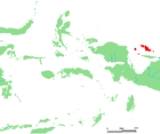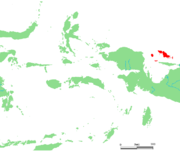
Schouten Islands
Encyclopedia

_topography.png)
Island
An island or isle is any piece of sub-continental land that is surrounded by water. Very small islands such as emergent land features on atolls can be called islets, cays or keys. An island in a river or lake may be called an eyot , or holm...
group of Papua
Papua (Indonesian province)
Papua comprises most of the western half of the island of New Guinea and nearby islands. Its capital is Jayapura. It's the largest and easternmost province of Indonesia. The province originally covered the entire western half of New Guinea...
province, eastern Indonesia
Indonesia
Indonesia , officially the Republic of Indonesia , is a country in Southeast Asia and Oceania. Indonesia is an archipelago comprising approximately 13,000 islands. It has 33 provinces with over 238 million people, and is the world's fourth most populous country. Indonesia is a republic, with an...
in the Cenderawasih Bay
Cenderawasih Bay
Cenderawasih Bay , also Teluk Sarera , formerly Geelvink Bay is a large bay in northern Province of Papua and West Papua, New Guinea, Indonesia, at . The Dutch name comes after a Dutch ship and family called Geelvinck...
(or Geelvink Bay) 50 km off the north-western coast of the island of New Guinea
New Guinea
New Guinea is the world's second largest island, after Greenland, covering a land area of 786,000 km2. Located in the southwest Pacific Ocean, it lies geographically to the east of the Malay Archipelago, with which it is sometimes included as part of a greater Indo-Australian Archipelago...
. The group consists of Biak Island, Supiori
Supiori
Supiori is an island just west of Biak in the Schouten Islands in Papua province, Indonesia. It has a rugged surface with highest point at 1034 metres. Its area is 659 square kilometres....
and Numfor, and numerous smaller islands, mostly covered in rain forest.
Ecology
These small islands have been designated the Biak–Numfoor rain forests as having the most highly endemic avifaunaBird
Birds are feathered, winged, bipedal, endothermic , egg-laying, vertebrate animals. Around 10,000 living species and 188 families makes them the most speciose class of tetrapod vertebrates. They inhabit ecosystems across the globe, from the Arctic to the Antarctic. Extant birds range in size from...
of any single area in the New Guinea region. The forest consists of similar types of trees to that on mainland New Guinea.
There are over 100 different birds on the islands, of which 11 to 16 bird species entirely restricted in their range to this small island group, including: Black-winged Lory
Black-winged Lory
The Black-winged Lory, Eos cyanogenia also known as Biak Red Lory is a medium-sized, up to long, long-tailed lory. It has a bright red plumage, black shoulder, red iris, an orange red bill and violet ear-patch behind eye. The underwings are red, becoming yellowish with black tips...
(Eos cyanogenia); the small tree-climbing Geelvink Pygmy Parrot (Micropsitta geelvinkiana); Biak Scrubfowl (Megapodius geelvinkianus); Spice Imperial-pigeon
Spice Imperial-pigeon
The Spice Imperial Pigeon is a species of bird in the Columbidae family.It is endemic to Indonesia.Its natural habitats are subtropical or tropical moist lowland forests and subtropical or tropical mangrove forests....
(Ducula myristicivora); Yellow-bibbed Fruit-dove
Yellow-bibbed Fruit-dove
The Yellow-bibbed Fruit Dove is a species of bird in the Columbidae family.It is found in Indonesia, Papua New Guinea, and Solomon Islands.Its natural habitat is subtropical or tropical moist lowland forests.-References:...
(Ptilinopus solomonensis); Biak Coucal
Biak Coucal
The Biak Coucal is a species of cuckoo in the Cuculidae family.It is endemic to West Papua, Indonesia.Its natural habitat is subtropical or tropical moist lowland forests.It is threatened by habitat loss.-Source:...
(Centropus chalybeus); two tree kingfisher
Tree kingfisher
The tree kingfishers or wood kingfishers, family Halcyonidae, are the most numerous of the three families of birds in the kingfisher group, with between 56 and 61 species in around 12 genera, including several species of kookaburras. The family appears to have arisen in Indochina and the Maritime...
s, Biak Paradise Kingfisher
Biak Paradise Kingfisher
The Biak Paradise Kingfisher is a tree kingfisher endemic to the Indonesian island Biak.-References:*...
(Tanysiptera riedelii) and Numfor Paradise Kingfisher
Numfor Paradise Kingfisher
The Numfor Paradise Kingfisher , also known as the Cobalt Paradise Kingfisher, is a tree kingfisher endemic to the Indonesian island of Numfor.-References:*...
(Tanysiptera carolinae); Biak Gerygone
Biak Gerygone
The Biak Gerygone is a subspecies of the Large-billed Gerygone, but it is sometimes considered a distinct species...
(Gerygone hypoxantha) (a subspecies of the Large-billed Gerygone
Large-billed Gerygone
The Large-billed Gerygone is a species of bird in the Acanthizidae family. The Biak Gerygone, formerly considered a distinct species, is now placed herein as a subspecies .- References :...
; Biak Monarch
Biak Monarch
The Biak Monarch is a species of bird in the Monarchidae family.It is endemic to West Papua, Indonesia.Its natural habitat is subtropical or tropical moist lowland forests.It is threatened by habitat loss.-References:...
(Monarcha brehmii); Biak Flycatcher
Biak Flycatcher
The Biak Flycatcher is a species of bird in the Monarchidae family.It is endemic to West Papua, Indonesia.Its natural habitats are subtropical or tropical moist lowland forests and subtropical or tropical mangrove forests....
(Myiagra atra); Long-tailed Starling
Long-tailed Starling
The Long-tailed Starling is a species of starling in the family Sturnidae. It is endemic to the Schouten Islands off West Papua, in Indonesia, an important area of bird endemism. The species was once treated as part of a superspecies with the Shining Starling...
(Aplonis magna); and Biak White-eye
Biak White-eye
The Biak White-eye is a species of bird in the Zosteropidae family.It is endemic to West Papua, Indonesia.Its natural habitat is subtropical or tropical moist lowland forests.It is threatened by habitat loss.-References:...
(Zosterops mysorensis). As well as the birds there are a number of endemic mammals, although there are only 29 mammals in total on the islands. The endemics include: Biak Naked-backed Fruit Bat
Biak Naked-backed Fruit Bat
The Biak Naked-backed Fruit Bat is a species of megabat in the Pteropodidae family. It is endemic to Indonesia.-References:* Chiroptera Specialist Group 1996. . Downloaded on 30 July 2007....
(Dobsonia emersaa) a species of barebacked fruit bat
Dobsonia
Dobsonia is a genus of megabat in the Pteropodidae family.It contains the following 13 species :Genus Dobsonia* Andersen's Naked-backed Fruit Bat, Dobsonia anderseni* Beaufort's Naked-backed Fruit Bat, Dobsonia beauforti...
(so-called because their wings are attached to the back rather than the sides, giving this type of bat a different appearance to most species; a marsupial Biak Glider (Petaurus biacensis); Japen Rat (Rattus jobiensis); and two species of Giant naked-tailed rat
Giant Naked-tailed Rat
The Giant Naked-tailed Rat is a species of rodent in the family Muridae.It is found in West Papua, Indonesia and Papua New Guinea.-References:* Baillie, J. 1996. . Downloaded on 9 July 2007....
Uromys boeadii and Uromys emmae
. The islands also have a number of endemic butterflies and one endemic spider Diolenius
Diolenius
Diolenius is a genus of the spider family Salticidae .-Species:* Diolenius albopiceus Hogg, 1915 — New Guinea* Diolenius amplectens Thorell, 1881 — New Guinea* Diolenius angustipes Gardzinska & Zabka, 2006 — Biak Islands...
angustipes|W.
Much of the forest has been cut down for logging or to clear land for planting especially on Biak Island, which is the most populous in the area, although logging has slowed down now. There are two protected areas, which are close to each other: Pulau Supiori Nature Reserve, which is most of Supiori Island; and Biak Utara Nature Reserve which is an area on Biak Island just across the bridge from Supiori. However the logging industry may return, while birds are vulnerable to collectors and just because they have such a limited range of habitat on these small islands. The area needs more study. Diving in the waters off Biak is a popular activity for tourists.

